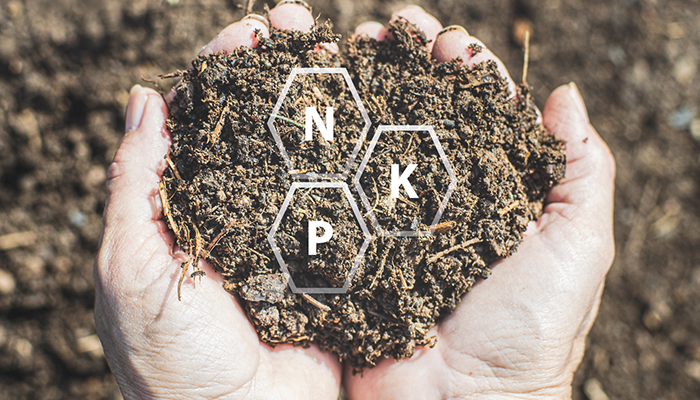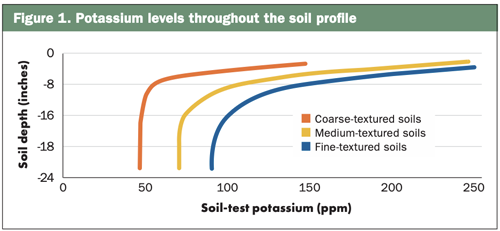
A balanced uptake of nutrients allows plants to thrive. Potassium (K) is one of the three primary nutrients, along with nitrogen and phosphorus, that is often applied in the greatest quantities. But how much potassium fertilizer you apply should depend on how much potassium is already in your soil.
Potassium is a cation that regulates metabolic functions inside the plant. It is associated with the movement of water, nutrients, and carbohydrates in plants, and it helps control enzymes that build protein and energy through photosynthesis. Therefore, potassium-deficient plants may be stunted, and potassium-deficient crops such as alfalfa may not persist over winter. Adequate potassium, on the other hand, will improve root growth and drought resistance. It is an element needed to maintain the quality of plants and their products by enhancing sugar and protein content, deterring diseases, and improving fiber integrity in crops like cotton.
The mineral composition of soil has a lot to do with whether potassium is present in sufficient quantity. The U.S. Geological Survey recently sampled soil across the conterminous U.S. and found that, in general, the northern half of the eastern U.S. is relatively high in potassium-bearing minerals and the southern half is relatively low.
That’s all fine and good, but how much potassium is in the soil on my farm? This question can only be answered by collecting soil samples and submitting them to a state or commercial lab for analysis. Not all labs extract potassium in the same way, so it will be important to know the method. When resampling soil over time, having analysis from the same extraction method is especially important to know if your management has effectively changed soil potassium content.
On-farm findings
Mehlich-3 extraction of soil nutrients is commonly used in many soil testing labs. When roughly 300 pastures were recently sampled across North Carolina, the average soil-test potassium was more than adequate for pasture production in the Blue Ridge and Piedmont regions of the state, but it was at the brink of sufficiency in the Coastal Plain region. But the average condition only tells part of the story.
When digging deeper into the data, 41% of samples were below sufficiency in coarse-textured soils, 29% were below sufficiency in medium-textured soils, and 20% were below sufficiency in fine-textured soils. This meant that 60% to 80% of samples were considered adequate in potassium to meet plant requirements. Soil testing helps determine if fertilizer inputs are needed and at what rate to alleviate deficiency. If potassium is sufficient, then supplying the soil with more potassium may not be so good for the pocketbook.
Hay production removes potassium from the field. For example, a ton of hay will typically contain 50 pounds of potassium. However, feeding hay on your farm means that you are supplying potassium to livestock that will excrete most of this potassium back to the soil.
Livestock grazing on pastures will redistribute potassium within the pasture wherever they urinate. Potassium is a soluble element that can leach from soil with excess precipitation. However, potassium is also a common cation that is attracted to clay minerals, so it can be bound or fixed into the soil mineral matrix. This fixation and subsequent release are reasons why soil minerals provide plant-available potassium over time. It is also a reason why soil extraction of potassium with soil testing is not always directly correlated with plant uptake and nutrient cycling.

Soil texture differences
Researchers investigated the distribution of soil-test potassium in a survey of 56 farms across North Carolina and Virginia, totaling 614 soil profiles. The figure indicates the median potassium levels when soils were sorted by soil textural group: fine-, medium-, and coarse-textured. In general, soil-test potassium was greatest in the top 4 inches and declined at depths of 4 to 12 inches and 12 to 24 inches. The finer the soil texture, the greater the concentration of soil-test potassium. The sufficiency level for soil-test potassium is considered to be within 50 to 100 parts per million (ppm), so deeper soil may provide good supply of potassium as well.
In summary, optimal forage production requires potassium fertilization when soil-test values are below sufficiency, but there is little economic gain from added potassium when soil-test values are at sufficiency or greater.
If you haven’t tested your soil recently, you might consider it, especially if your routine fertilization strategy is becoming more expensive.
This article appeared in the November 2025 issue of Hay & Forage Grower on page 19.
Not a subscriber? Click to get the print magazine.
